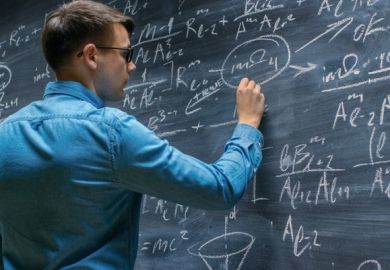Here's a way to make a million dollars. Start by adding the fractions 1 + 1/2 + 1/3 + 1/4 + 1/5... Their sum is called "the harmonic series". It "diverges". The sum gets bigger and bigger, beyond any limit, if you add enough terms.
But you can tame it with a simple trick. Raise the denominators 2, 3 and so on to some power, say a square or a cube. That makes each term smaller. Then the series converges to a finite sum. For instance, the sum of all the infinitely many terms 1 + (1/2)2 + (1/3)2 + (1/4)2 + (1/5)2... adds up to p2/6. As long as the power or "exponent" on the fraction is bigger than 1, the series converges.
And the exponent can vary. Let's call it s. Then, depending on s, if s is greater than 1, the infinite series 1 + (1/2)s + (1/3)s + (1/4)s + (1/5)s... defines a definite sum. It is a "function of s". Let's call it "zeta." It is the zeta function, zeta(s).
Now, about that million dollars? Well, the exponent s can be what is called a "complex number". That is, a number of the form a + b v-1, where a and b are ordinary real numbers. But v-1 doesn't exist! Never mind, just call it i. You see, there is a nice way to make sense of 2i or 3i and even ii.
Let's leave the details for later. As long as a is bigger then 1, the series converges with the exponent s= a + bi.
We are getting close to the money part. This zeta function has some really weird properties. For instance, it satisfies a certain "functional equation" (details later) which gives zeta at s - 1 in terms of zeta at s.
So, even though the series blows up (goes infinite) if the real part of s is less than or equal to 1, the functional equation allows you to define and calculate zeta for values of a (the real part of s) smaller than 1.
Now for the kicker. Does the zeta function ever equal zero? Are there any values of s that make zeta(s) "vanish" (become zero)? Yes, it does, and there are. Those special values of s, which make zeta of s equal zero, are of two kinds - trivial and interesting. We shall see in a minute what makes some of them interesting. The trivial ones are s= - 1, s= - 2, s= - 3 and so on. Then there are the interesting ones. There are infinitely many of them with a, the real part of s, exactly equal to 1/2.
Why exactly equal to 1/2? A good question. Now, here is the prize problem.
Prove that if zeta of s= 0 and s is not a trivial zero (-1, - 2, - 3 and so on) then a, the real part of s, must be equal to 1/2.
Why is this weird problem worth $1,000,000? And who will pay it? The Clay Mathematics Institute will pay it, absolutely, no worries. The prize has been publicised, the money is there. (In fact, this is one of seven $1,000,000-dollar problems.) Why is it worth $1,000,000? Because most of the greatest mathematical analysts of the 20th century broke their teeth on it. Including England's G. H. Hardy, of course.
Why did they care that much? Because the problem comes from the most basic part of mathematics - arithmetic - and the most basic part of arithmetic: the "prime numbers". Those are the "unfactorable" numbers, such as 2, 3, 5, 7, 11, 13, 17, 19, 23, 29, 31 and so on, from which all the other numbers are obtained by multiplication.
The zeta function is a secret code for the whole set of infinitely many prime numbers! Leonhard Euler discovered that the zeta function "wraps up" all the primes into one tight little package. He found that the harmonic series can be factored into sums of powers of primes.
Euler multiplied(1 + 1/2 + (1/2)2 +(1/2)3 +...) times (1 + 1/3 + (1/3)2+ (1/3)3 +...) times (1 + 1/5 +(1/5)2 + (1/5)3 +...) times (1 + 1/7 + (1/7)2 + (1/7)3 +...) times... and so on. He multiplied together all the sums of fractions of the form 1 + 1/(prime number)n. And he got 1 + 1/2 + 1/3 + 1/4 + 1/5 + 1/6 ... The harmonic series! The harmonic series ties all the primes together in one neat bundle.
It is true that both of those expressions, the product and the series, blow up to infinity. So, Euler tamed them by taking the primes and their products, the denominators in the harmonic series, to a power s greater than 1.
The backbone of arithmetic, the infinite sequence of primes, is coded, disguised as a new kind of object, a function. And a nice function, an analytic function of a complex variable. So one can analyse the distribution of the primes by studying the zeta function. And the theory of functions of a complex variable is the most versatile, powerful tool of classical mathematics.
The prime numbers, elementary as they are, are a great mystery. They can be listed as far as you like, but their distribution, the length of the gaps between each one and the next, seems completely arbitrary. "Random", as people say. And yet, on average, if you ask how many primes there are, up to a certain bound, it turns out that they are amazingly orderly. If you plot a graph of the logarithm of n times the number of primes less than n, you get virtually a straight line.
This fact can be proved rigorously. It is called the prime number theorem
It was proved in the 1890s by Jacques Hadamard and Charles de la Vallée Poussin, using complex numbers, and in 1949 by Atle Selberg and Paul Erdos, bare-handed.
The zeros of the zeta function came to the attention of Bernhard Riemann when he was searching for a better formula for the distribution of the primes. He found a very close approximation that would be justified if only we knew that all the non-trivial zeroes have real part equalling exactly 1/2. This is "the Riemann hypothesis". And machine computations have checked out the first hundred billion zeros - they all have real part exactly equal to 1/2. Yet the final proof, that all of them do so, is devilishly hard.
There are several amazing surprises in the long history of mathematicians' assaults on this mathematical Mount Everest. Riemann's work on the distribution of primes is all contained in a brief note published in 1859.
He was also busy with momentous new ideas in geometry (Riemann surfaces, Riemannian metrics, the Riemann sphere) and mathematical physics (the Riemann problem) and analysis (the Cauchy-Riemann equations, the Riemann mapping theorem), to name a few.
After he died young of consumption, many of the papers he left behind were burnt by his landlady. The rest were saved by his widow and kept private.
Sixty years after Riemann's death, a young German mathematician, Carl Ludwig Siegel, got access to some of Riemann's leftover scraps. They were hardly legible, but he managed to decipher an amazing lost formula, too complicated to write down here. Restored to the mathematical world under the name of the Riemann-Siegel formula, it was the key ingredient that made possible the machine computations that checked Riemann's hypothesis for the first hundred billion cases.
In the 1970s, an amazing connection was discovered between Riemann's zeta function and quantum physics. A young American number theorist, Hugh Montgomery, on a passing visit to the Institute for Advanced Study in Princeton, was by chance introduced to the famous physicist resident there, Freeman Dyson. Dyson politely asked Montgomery what he was working on.
Montgomery had been tabulating the distances between the interesting zeroes of the zeta function, located all on the line, "real part of s= 1/2".
Dyson cried out in astonishment - their distribution was identical to one he was familiar with: the statistics of the energy levels of a heavy atom such as uranium.
This "random event" at the Princeton institute stimulated a new burst of investigation, comparing relevant features of the random unitary matrices of quantum mechanics with comparable numbers associated with the zeta function. Michael Berry and Jonathan Keating of Bristol University played leading roles in these studies. Amazing matches were found for the "moments" of the physics and the zeta function. Of course, these confirmations of the close match between the zeta function and random matrices stimulated new hopes for proving the Riemann hypothesis. They revived an old suggestion of George Polya and David Hilbert, to make a connection between the line "real part of s= 1/2" for the zeta function and the real axis, in relation to some suitable self-adjoint linear operator. But these hopes, so far, have not been fulfilled.
These two books tell the story well, in two different styles. The Music of the Primes gives the poetry, the imagery, the tantalising ramifications.
Marcus du Sautoy is a mathematician (at Oxford University), and reading him you will hear the thinking and dreaming of real live mathematicians today.
Prime Obsession is written by a mathematics enthusiast, a very serious amateur. John Derbyshire's book starts with simple algebra and arithmetic, and leads you close to the active area of research. Necessarily, the going gets tougher as you approach the top. As a mathematician, I am delighted that these two books are available to the mathematically interested lay public.
Reuben Hersh is emeritus professor of mathematics, University of New Mexico, US.
The Music of Primes: Why an Unsolved Problem in Mathematics Matters
Author - Marcus du Sautoy
Publisher - Fourth Estate
Pages - 335
Price - £18.99
Register to continue
Why register?
- Registration is free and only takes a moment
- Once registered, you can read 3 articles a month
- Sign up for our newsletter
Subscribe
Or subscribe for unlimited access to:
- Unlimited access to news, views, insights & reviews
- Digital editions
- Digital access to THE’s university and college rankings analysis
Already registered or a current subscriber? Login


